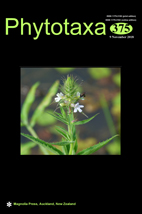Abstract
Morphologically, recognition of the genus Plagiomnium may be relatively easy. Yet identifications of closely related species have met great difficulties. The contemporary species delimitations of P. carolinianum, P. maximoviczii, and P. rhynchophorum largely based on sexuality as the sole distinction have not been satisfactory. As shown from literature, character variations among these three taxa were continuous and intergraded within or among different populations throughout a wide geographic range. No gametophytic characters could be reliably used to distinguish them from each other. Molecular phylogenetic analyses using ITS2 and rps4 gene were undertaken to resolve delineations for these three morphologically similar species. The results suggest that they form a well support monophyletic clade, which can be defined as representing one single species with two subspecies, i.e. P. rhynchophorum subsp. maximoviczii and P. rhynchophorum subsp. rhynchophorum. The present molecular study supports the treatment of P. carolinianum as synonym of P. rhynchophorum as purposed previously by Koponen based on morphology.

